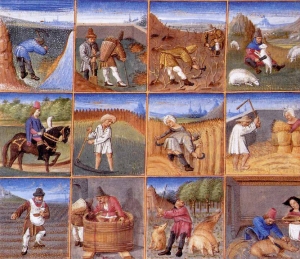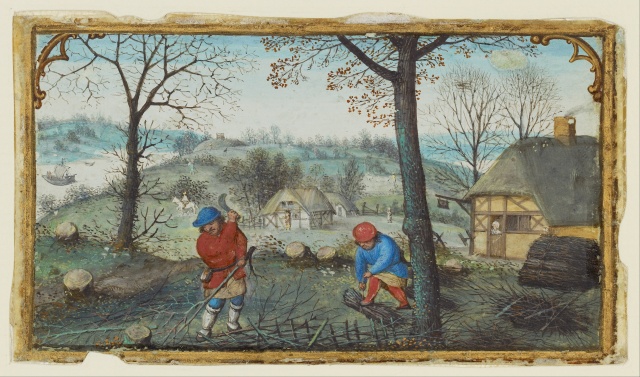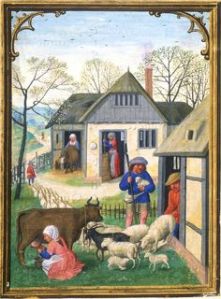Mark Hailwood
In a nutshell, the aim of our project is to gather an unprecedented level of information about women’s work in early modern England (1500-1700) by drawing on incidental information about everyday work activities contained in witness statements given before the courts. When you crack open the nutshell, though, it soon becomes clear that such an endeavour is far from straightforward.
First of all, there is the issue of how we define work. This is something Jane has already blogged about, here, but if you want another ‘nutshell’ summary, we are defining it as: any activity that could be substituted with purchased goods or services. Then, though, there is the issue of what we mean by a work ‘activity’. This is an issue I’ve tackled in another blog post, here, the nub of which is that we are focusing on specific work tasks (mowing grass, shearing sheep), rather than more general activities that contribute to making a living (owning a farm, working in service) that are composed of a wide range of unspecified tasks – we want to build an understanding of historical work patterns out of the most basic unit of work: the individual task.
So, we’ve got our ducks in a row on these issues, but how do we translate these principles into a working methodology that we can apply to our sources? Well, we’ve been working on this too, and in this post I want to set out some of the nuts and bolts of our methodology for identifying work activities in the archive and for recording them. We would welcome any feedback you might have in the comments section.
It starts with me reading through a batch of quarter sessions examinations, church court depositions, or coroners’ reports. What I’m looking for are examples of work activities that fit the following criterion, which I then record in our database:
(a) a specific individual (b) professing to have done or observed doing (c) a specified work activity
Simple enough on the surface – but each of these components comes with some additional criteria:
(a) a specific individual
As a minimum requirement for an individual to be recorded we need a gender – for a project about the gendered character of work this is an important piece of information! Any other information (names, age, etc) is recorded but not essential. (It’s worth pointing out here that we are recording both women’s and men’s work, to allow us to compare the two). It must also be clear that that individual has engaged in the work act themselves, not potentially employed someone else to do it for them (for instance, a farmer may talk about ‘growing oats on his land’, but that would not be sufficient evidence that he himself either sowed or harvested the same – he could possibly have paid others to do all of these tasks).
(b) professing to have done or observed doing
The crucial thing to note here is that we are not looking for definitive proof that an individual did an activity, only that their story is plausible. For instance, in many court cases an individual will claim to have bought a sheep they are accused by other witnesses of stealing. We do not want to try and second guess the ‘truth’ of these claims, so where a plausible account of a work activity is provided we will record it, adopting a kind of Natalie Zemon Davis ‘fiction in the archives’ approach – it must have needed to be plausible if it was going to convince the court.
Take the following example: in 1598 one Thomasine Weather was accused of having stolen a sheep, but claimed that she could not have done so because at the time of the crime she had been elsewhere. She deposed that
‘upon Thursday was fortnight about five of the clock in the afternoon, she went forth from her mother’s house to fetch a burden of wood, who went for the same to one Henry Burnard’s ground called the Butte Moore about a quarter of a mile off, and then returned home again about six of the clock in the same night, and after that stayed in her mother’s house all night.’
True or not (and it seems from other witness statements in the case that it may not have been – they all had different versions of precisely when she had gone out and come back, and what sort of wood she had gathered) we would nonetheless record this as a plausible account of a work activity: fetching wood.
(c) a specified work activity
Anything that comes under the ‘3rd party criterion’ I’ve already discussed – any activity that could be substituted with purchased goods or services – whilst relating to a specific task (spinning, mowing etc) rather than being a more general description such as ‘service’ or ‘labouring’ that could encompass any range of work activities. There are also some exclusions here though, designed to eliminate certain activities that would otherwise swamp the database: one is criminal activity itself (especially theft) – not because we don’t consider it as a form of work, but because it would end up accounting for 90% of our entries given its prominence in the quarter sessions in particular. Another exclusion is the preparation of tithe corn for collection, and said collection, as this again would end up being significantly over-represented by the large number of tithe cases in the church court records. The principal, as much as possible, is to try and record activities that are incidental to the case itself, rather than the central subject of it.
Another illustrative example might be useful to highlight how some of these criteria apply in practice. This is the deposition of Alice Kingston, of Exeter, Devon, given in a church court tithe case in 1634: She said that
[she] ‘did live with Mr Street late of St Edmund’s parish three years and half or thereabout ended now about a year since, and in that time the said Mr Streete did keep three milk kyne [cows] which commonly all the summer time did pasture upon the grounds of [Mr] Joanes in every the said years … and saith that this deponent hath divers tymes in the said years milked the said kyne in the grounds called the shillowes.’
What would we record here? Well, we record Alice Kingston as a specified individual, professing to have done a specific work activity, milking cows. We would not record anything else: Mr Street may have helped to secure a living by ‘keeping three milk cows’, but there is not enough evidence here to say what activities, if any, he was involved in as a result: he may simply have owned them, and paid others – such as Alice Kingston – to do the specifics of ‘keeping’ them. Mr Jones may have taken cows in to pasture on his land as a way of making a living – again, though, its not explicit what specific tasks this involved him in.
So, that’s the basics of how we decide whether to record an activity. When an activity has passed the test, we are then recording as much contextual detail as we can about the individuals involved and the context in which the activity took place. Where it is provided – and almost all of the following categories are unevenly recorded across our sources – we are recording the name, age, marital status, and parish of residence of our actors. We are also recording any occupational or status descriptors accorded to them – something that will allow us to compare occupational titles with the work activities an individual actually engaged in. With regards to the activity, we are recording the day, month and year, the time it took place, and any information about its location or duration. We are also recording information about employment relations: for instance when a work task has clearly been undertaken for another person, and where there is clear evidence whether it was paid work, or done as part of service, and so on. We are hoping, then, that this information will allow us to analyse the ways in which both women’s and men’s work was structured by age, by seasonality, by space, and so forth, as well as by gender.
Significant results on any of these issues are a long way off yet, but now we’ve decided what work is and how to find it the database is starting to fill up – so keep watching this space (we may even unleash some preliminary results soon…)




Pingback: Workers of the Week: Autumnal Gatherers and Cider Makers | Women's Work in Rural England, 1500-1700
Pingback: Workers of the Week: Night Owls | Women's Work in Rural England, 1500-1700
Pingback: Workers of the Week: Family Fortunes | Women's Work in Rural England, 1500-1700